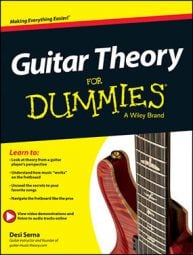Like the spaces between natural notes, the spaces between intervals on the guitar are filled with flats and sharps. For example, the 1st and 2nd major scale degrees are a whole step apart, meaning they have a pitch in between them. This pitch is called a flat 2nd (f2) because it’s one half step lower than a 2nd interval. Here are the rest of the flats that appear between the major scale degrees:
Flat 3rd (f3): The pitch in between 2 and 3
Flat 5th (f5): The pitch in between 4 and 5
Flat 6th (f6): The pitch in between 5 and 6
Flat 7th (f7): The pitch in between 6 and 7
![[Credit: Illustration courtesy of Desi Serna]](https://www.dummies.com/wp-content/uploads/415841.image0.jpg) Credit: Illustration courtesy of Desi Serna
Credit: Illustration courtesy of Desi Serna
Some flats can also be considered sharps. For example, you can also call a flat 5th a sharp 4th (s4). However, musicians usually use the term flat in these cases because flats are used to identify minor intervals. For example, a flat 3rd is also called a minor 3rd, a flat 6th is also called a minor 6th, and a flat 7th is also called a minor 7th.
You may notice that some 3rds are one half step lower than others. For example, in the G major scale, G and B (G-A-B) are two whole steps apart, while A and C (A-B-C) are only one and a half steps. The distance from G to B is major, while the distance from A to C is minor, which is why the same intervals are called major and minor 3rds.
When you play the major scale in 3rds, notice that three of the scale degrees have major 3rds, while four of them have minor 3rds. Specifically, the formula is major-minor-minor-major-major-minor-minor. They each have what’s called a perfect 5th, except for the last one (which has a flat 5th).

